Watering cacti spraying care buy cactus / KAKTUSENOK.RU
He sleeps and is not watered (subject to cold wintering!). But even this rule has exceptions. Young cacti and prone to strong dropping (drying out) should be periodically removed from the wintering site, transferred to a warm, well-lit room. After the cactus warms up, water it, let the soil dry for several days and send it on to sleep in the cold. As a rule, during the winter dormant period from November to March, at temperatures in the winter road of about +10, one such watering is sufficient. Some types of cacti must be watered in winter. These primarily include (Notocactus) and fraileys (Frailea). With the first, in the absence of watering, nothing terrible will happen, but as a punishment, notocactus can leave you without flowers. It has been noticed in practice that too long a lack of watering (for 4 or more months) negatively affects future flowering, while outwardly notocactus, they never look exhausted during the winter. WITHeverything is a little more complicated, if you do not water this species, somewhere in the middle of winter, in the spring you may not get them at all. Fraileys buried in the ground and strongly settled, must be watered abundantly, otherwise they will not react to the water. In the photos below, Frailea carminifilamentosa extracted from the "wintering", before and after watering.
Watch the thorns as much as possible !! It is not a fact that a young cactus will need watering, everything is strictly individual !! When you see that the whole cactus has shrunk, covered with wrinkles, shriveled, lost the normal color of the epidermis, and it is only the end of December in the yard, then it is necessary to carry out the "resuscitation" procedure described above. As an example, I would like to cite two cacti wintering in equal conditions. Parody underground (Parodia subterranea) and(Gymnocalycium amerhauseri)
Both received the last watering at the end of October, these photos of cacti were taken in the last days of December. The parody is small, young, about 3 years old. Gymnocalycium is twice as large and older. But in fact, the parody tolerates dry wintering much better and, unlike the second cactus, does not have any signs of subsidence from lack of water, despite the fact that the hymnocalycium looks pretty "dented".
If cacti are in a warm room in winter, with temperatures above 18 - 20 degrees, then watering cannot be avoided. But very moderately and no more than 1 - 2 times a month. Can be replaced by spraying. Pampering cacti with water begins in March, as warm weather sets in. But if on the calendar March 1, but at the same time on the street -20 and deep clouds, then watering should be postponed to a later time.
.
Watering cacti in the summer
It is advisable to defend and boil water for irrigation (if you have a well, then this is not necessary)). Excess lime and high hardness in tap water interfere with normal root respiration. Water the cacti with warm water, not lower than room temperature. Cacti are one of those who "love it hot" in the literal sense of the word. The optimum temperature is about 30 - 35 degrees. About once a month, cacti can be watered for more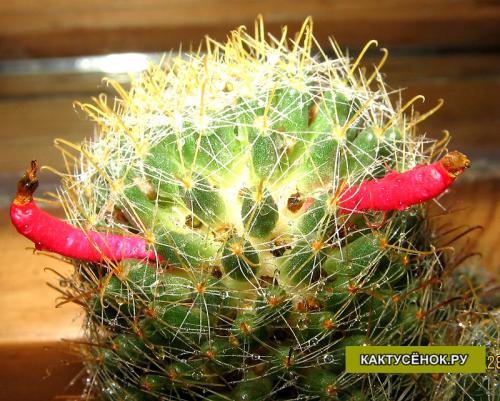 e with hot water, +50 - 55 degrees. This procedure stimulates root growth andA pot with a cactus is either placed in a container with hot water, or poured through the top of the pot, as with ordinary watering, but trying not to get directly on the cactus itself. It is not necessary to pour hot water on the head of the cactus, you can burn the skin. This is not fatal for him, but spots may remain in the places of burns. And here
you can even use slightly hotter water. The fact is that when sprayed, water very quickly loses its original temperature. and at the exit it is difficult to get even +40. Watering and spraying with hot water is good for spring, to awaken cacti after hibernation. Cacti can be watered through a tray, bowls, saucers, in short, what you have a cactus in (bottom watering) or in the usual way on top of a pot. A cactus does not matter where the water comes from. The main thing is not to fill in and do not water cacti on wet ground! Watering cacti is done only after the topsoil has dried out. When watering through a pan, after 20 - 30 minutes, so that the roots do not rot, do not forget to drain the remaining water if the cactus has not "drunk" everything. Bottom watering is convenient and uncontested if the cactus has grown and occupied the entire pot and there is simply no way to get to the ground with a watering can.
e with hot water, +50 - 55 degrees. This procedure stimulates root growth andA pot with a cactus is either placed in a container with hot water, or poured through the top of the pot, as with ordinary watering, but trying not to get directly on the cactus itself. It is not necessary to pour hot water on the head of the cactus, you can burn the skin. This is not fatal for him, but spots may remain in the places of burns. And here
you can even use slightly hotter water. The fact is that when sprayed, water very quickly loses its original temperature. and at the exit it is difficult to get even +40. Watering and spraying with hot water is good for spring, to awaken cacti after hibernation. Cacti can be watered through a tray, bowls, saucers, in short, what you have a cactus in (bottom watering) or in the usual way on top of a pot. A cactus does not matter where the water comes from. The main thing is not to fill in and do not water cacti on wet ground! Watering cacti is done only after the topsoil has dried out. When watering through a pan, after 20 - 30 minutes, so that the roots do not rot, do not forget to drain the remaining water if the cactus has not "drunk" everything. Bottom watering is convenient and uncontested if the cactus has grown and occupied the entire pot and there is simply no way to get to the ground with a watering can.
In summer, cacti are watered on average 1 - 2 times a week and not drop by drop, but normally, as you would water any other plant, but on a mandatory condition - dry topsoil... And if the heat is under 40 and even more often. But make an obligatory adjustment for your conditions and, first of all, for the size of the pot, and the composition of the soil. In spacious pots we water less often, as the soil dries out longer. If the cactus is planted in soil with a small amount of baking powder and consists mainly of sod land, which, in principle, is not initially correct, then you increase the interval between watering, because suchkeep water for a long time. More rare watering is needed especially for "drought-loving" cacti, which have this feature,usuallycan be noted in the description of the species. These include such types as(Turbinicarpus), epithelants (Epithelantha), ariocarpus (Ariocarpus), etc. These cacti need to be watered only after the soil has completely dried out and even the cacti themselves have subsided somewhat.
An example is the adult Echinocactus grusoni (Echinocactus Grusoni ) ... The larger and older the specimen, the less water it needs. . I water my load 1 - 2 times a month, even in the heat of summer. The main thing is to deduce for yourself a simple pattern: the lower the temperature and less sun, the less often we water and vice versa!
.
Spraying cacti
For hygienic purposes, cacti should be regularly sprayed warm water, about 30 - 40 degrees,you need to do this about 1 time in 10 days.At the same time, you will have a great opportunity to see how magnificent they are, hung with clusters of dewdrops sparkling in the light. Alas, even this simple procedure requires a certain amount of knowledge about correct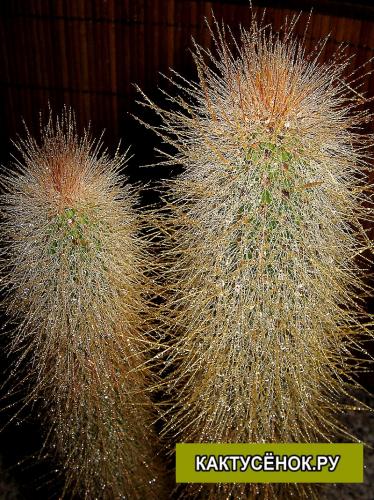 cactus care. Once on one of the forums, I read a user's reply that he tries never to spray cacti, so they then begin to become covered with rot of various etiologies. I was somewhat puzzled by this statement, but then I realized what was the matter. Spraying cacti should be taken as seriously as watering. …. and stick to the same rules. If you arm yourself with the knowledge that the main enemies of any cactus- this isCOLD +
DAMPNESS
, then we can come to the conclusion hthensprayingniecacti in cool, damp weather, for example, on a glassed-in balcony with closed windows can lead to the appearance of these very rot. And get hurt first
cactus care. Once on one of the forums, I read a user's reply that he tries never to spray cacti, so they then begin to become covered with rot of various etiologies. I was somewhat puzzled by this statement, but then I realized what was the matter. Spraying cacti should be taken as seriously as watering. …. and stick to the same rules. If you arm yourself with the knowledge that the main enemies of any cactus- this isCOLD +
DAMPNESS
, then we can come to the conclusion hthensprayingniecacti in cool, damp weather, for example, on a glassed-in balcony with closed windows can lead to the appearance of these very rot. And get hurt first b cacti with dense thorns (as in the photo on the left) and pubescent toactssuch as Oreocereus and as the most striking example of Mammillaria BokassToand I(photo below). The longer the cactus body does not dry out after sprayingvanie, themorevethe likelihood of the onset of the development of unwantedfungi
. NS Try spraying ferocactus horridus and you will see it dry in 10 minutes. And Cleistocactus tupisensis or Strauss's Cleistocactus? These cacti will hold thousands of water droplets on their countless thorns for many hours..
In the photo on the left, glue
b cacti with dense thorns (as in the photo on the left) and pubescent toactssuch as Oreocereus and as the most striking example of Mammillaria BokassToand I(photo below). The longer the cactus body does not dry out after sprayingvanie, themorevethe likelihood of the onset of the development of unwantedfungi
. NS Try spraying ferocactus horridus and you will see it dry in 10 minutes. And Cleistocactus tupisensis or Strauss's Cleistocactus? These cacti will hold thousands of water droplets on their countless thorns for many hours..
In the photo on the left, glue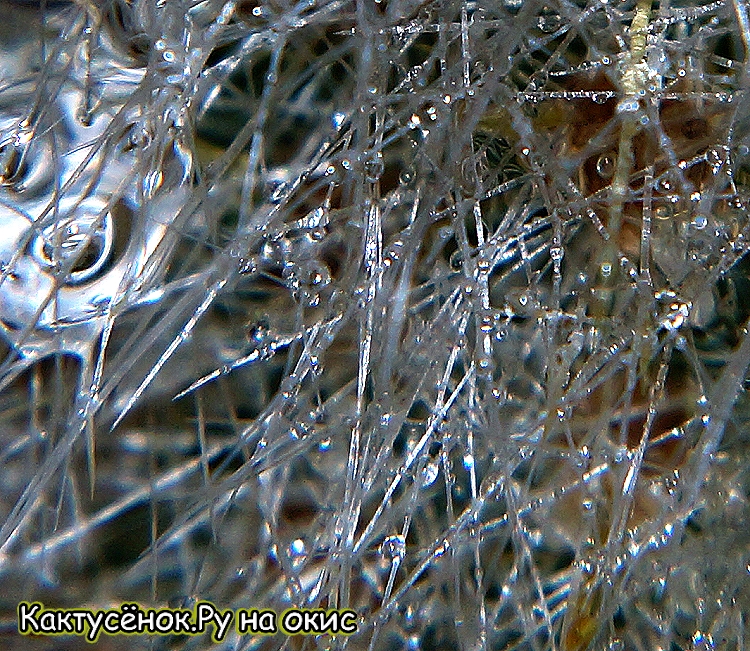 ystokactus after spraying, the picture was taken with some magnification and inyou can see what is not visible to the unarmedm look.
ystokactus after spraying, the picture was taken with some magnification and inyou can see what is not visible to the unarmedm look.
So, we draw the next conclusions. It is better not to spray cacti in the late evening - at night, always colder than during the day. In rooms with poor air ventilation, at low temperatures and high humidity.Low temperature can be understood as all parameters of neither+18 +20 degrees. Pubescent cacti with multiple oxOski, it's better not to spray at all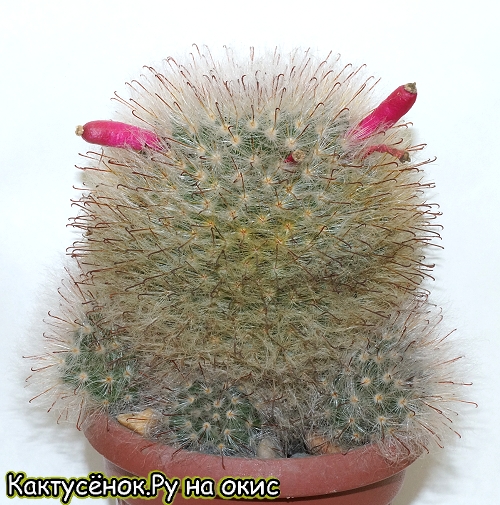 vat - this reduces their decorativeb and as already mentioned above, the moste vulnerable. By the way, in winter this procedureat the sameit is necessary to do it, only much less often 1-2 times a month and, accordingly, spray only those cacti that are not in a cold wintering in closed greenhouses
.
vat - this reduces their decorativeb and as already mentioned above, the moste vulnerable. By the way, in winter this procedureat the sameit is necessary to do it, only much less often 1-2 times a month and, accordingly, spray only those cacti that are not in a cold wintering in closed greenhouses
.
.
Determine whether or not to water the cactus
Closer to autumn, with the onset of cool weather, watering should be gradually reduced to gradually prepare the cacti for wintering. Since my thorns are in the outdoor greenhouse until November, I have been reducing the number and volume of irrigation from the beginning of September. And a little advice for beginners, so that they do not suffer with the question "to water now or wait until tomorrow ????". If the ground is wet under the cactus, definitely do not water it. If you have lifted the pot and there are traces of moisture on the pallet, although the top layer of the earth is dry, then also wait with watering. I used a little trick at one time. I took an ordinary wooden toothpick and very carefully pierced the ground right at the side of the pot, if the toothpick turned out to be wet with adhering particles of earth, then the watering was canceled. Well, if it is completely dry, then you could please yourself and the cactus with water procedures.Also, whether it is necessary to water the cactus can be understood by the weight of the pot. If your cactus is planted in a plastic pot, then over time you can learn to determine the need for watering, let's say, by "weight". Water the cactus, and then lift the pot, and you can feel its approximate weight when the soil is saturated with water. When, according to all the signs listed above, it is time to water the cactus, lift the pot again and you will notice how much lighter it has become. The arms will "remember" the oriented weight difference. This method is especially convenient with tall cacti, if the soil in the pot is very dry, then the pot with soil will become lighter than the cactus itself, which means the center of gravity will be on top and some instability will appear, the cactus itself, if slightly tilted, will outweigh the pot.
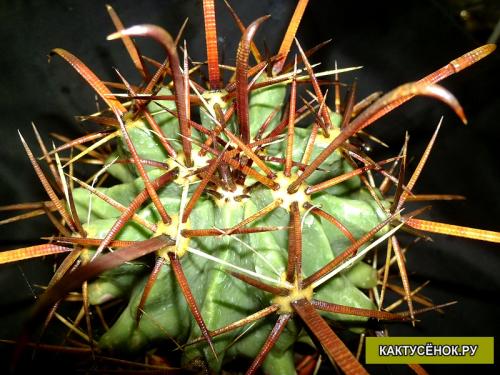
To top it off, I want to say that I am by no means a claimyu, to the laurels of the "cactus guru" Everything that is written here is my personal experience, conclusions and observations. My cacti are growing, many are blooming and the collection is constantly replenished with seedlings grown from seeds. Of course, there will be a certain number of cactusists with great experience and knowledge who will disagree with me on some issues.
Last revised January 2017
WHEN USING THE MATERIALS, A LINK TO THE SITE IS OBLIGATORY !! ---------- HERE YOU CAN LEAVE YOUR COMMENTS




